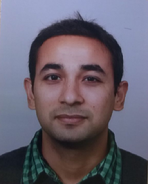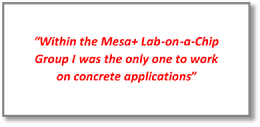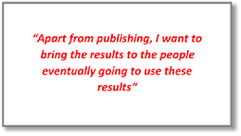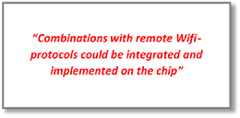 This thesis aims at building a new type of chloride sensor system for concrete, based on dynamic electrochemical measurement with embedded corrosion sensors. ‘The application oriented content of the work was important to me,’ says Yawar Abbas. ‘I chose a two-fold approach. First a dynamic electrochemical technique without the need for a reference electrode (a reference free technique) and, secondly, an alternative for a long-term reference electrode, using activated carbon possessing huge double layer capacitance.’
This thesis aims at building a new type of chloride sensor system for concrete, based on dynamic electrochemical measurement with embedded corrosion sensors. ‘The application oriented content of the work was important to me,’ says Yawar Abbas. ‘I chose a two-fold approach. First a dynamic electrochemical technique without the need for a reference electrode (a reference free technique) and, secondly, an alternative for a long-term reference electrode, using activated carbon possessing huge double layer capacitance.’
Chloride ions are one of the major contributors to degradation of reinforcement-concrete. Measuring the levels Yawar worked on a lab-on-a-chip method, to be embedded in concrete constructions without damaging or weakening it.

‘The sensors are embedded near the splash zones, where salt water and air leads to corrosion the most,’ he says. ‘Using lab-on-chip technology, the segment can be monitored in situ.’
Electrochemical monitoring
While performing his PhD research Yawar was inspired by combining existing techniques. ‘The challenge is to come up with a stable and robust product, feasible in the near future,’ he says. ‘The innovative and scientific aspects concern the electrochemical monitoring principles.’
He worked on a chrono-potentiometric measurement method. This is a dynamic electrochemical approach based on current flow through a silver-silver chloride electrode, and further analyze the chloride-ions to flow down over time. ‘Despite the limited accuracy the method is promising as a trend can be monitored clearly. When certain previously set limits are detected, a crucial event, also known as transition time, is detected indicating real internal damage.’
Carbon electrodes

A second approach was on an alternative for a long-term reference electrode, getting rid of unwanted ‘drift’ in reference potentials causing flawed data. Therefore, an activated carbon electrode was evaluated as a pseudo-reference electrode.
Yawar: ‘The results on both topics led to publications in Journal of Analytical Chemistry Acta, and in the Journal of Construction and Building Materials. Within the Mesa+ Lab-on-a-Chip Group I was the only one to work on concrete applications. Nevertheless, my colleagues always supported me. And during the poster presentations on the annual Mesa+ Days, I received very positive attention and interesting questions from other Mesa+ colleagues regarding my research work.’
User group
Every six months Yawar discussed his progress with a users-group in which collaboration partners from industry were represented, including Rijkswaterstaat, Strukton and ConSensor. Collaboration was started as well with the MicroLab Group of TU Delft, using their materials expertise on concrete.

‘These aspects motivated me greatly,’ Yawar says. ‘Apart from publishing, I want to bring the results to the people eventually going to use these results. Now Rijkswaterstaat is about to continue the project. Combinations with remote Wifi-protocols could be integrated and implemented on the chip. Apart from this further design improvements of the electrodes are requisite.’
Yawar also liked his work as a teaching assistant during the PhD project, supervising up to seven projects of master and bachelor students. ‘Collaborating with motivated people and guiding them through complex projects, I would like to include in my future job which would preferably be as a researcher in industry. Working for a medium-sized high-tech company appeals to me. For example Micronit, a spin-off company of the University of Twente, would suit my ambitions very well.’
